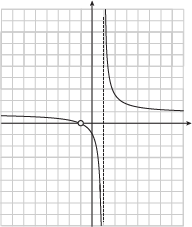We've heard it all before. "We can't divide by zero." "We can't have a denominator equal to zero." "A rational function is undefined if the denominator is zero." "If you keep making faces like that, it'll stick that way."
What actually happens if we go ahead and try to do it anyway? For one, we'll have a face that is great for Halloween but bad for any future job interviews. For the whole "division by zero" thing, we get a vertical asymptote.
A vertical asymptote is a line that a function approaches but never quite touches; think of the function like Charlie Brown, and the vertical asymptote is a football. Division by zero is the Lucy of this analogy, pulling the asymptote away from the function at the last second.

The line x = -2 on this graph is a kind of electric fence perpendicular to the x-axis. It causes a bend in the graph of the rational function. It gets very, very, very close to x = -2 but never touches it. It's not actually part of the graph, it just tells us where our function doesn't go.
This graph is for the function  . Check out that denominator: it equals zero when x = -2, just like we were saying. Division by zero causes vertical asymptotes. Sometimes we have to do some hunting for them, though.
. Check out that denominator: it equals zero when x = -2, just like we were saying. Division by zero causes vertical asymptotes. Sometimes we have to do some hunting for them, though.
Sample Problem
Find any vertical asymptotes of  .
.
It's just like Mama always said. Life is like a polynomial; factoring will help us find the zeros.

We've got a twofer here, at x = -1 and 3. The function approaches both of these lines, but doesn't cross either one. We wouldn't want to cross an asymptote either; we've heard some scary rumors.
Falling Into A Hole
"Division by zero causes vertical asymptotes." We just said that a minute ago. It isn't quite always true, though. Sorry, but there is one big exception to this rule. It's what happens when division by zero cancels out of a rational expression.
Sample Problem

This is the graph of  . Nothing appears wrong with this, until we realize that x = -1 and 1 both cause the denominator to equal zero. We only have one vertical asymptote, though. Is everything we thought a lie?
. Nothing appears wrong with this, until we realize that x = -1 and 1 both cause the denominator to equal zero. We only have one vertical asymptote, though. Is everything we thought a lie?
Not quite; if we look really close at x = -1, we see a hole in the graph, called a point of discontinuity. The line just skips over -1, so the line isn't continuous at that point. It's not as dramatic a discontinuity as a vertical asymptote, though.
In general, we find holes by falling into them. We don't pay a lot of attention to where we're walking. In rational expressions, we find holes by simplifying the expression.


We cancel out the (x + 1), causing the division by zero to "disappear." However, and this is important, it is still actually there. That's what makes the hole appear. That, or playing t-ball in the house.
The expressions  and
and  are graphed the same, except that our original expression has that extra hole in the graph at x = -1. If we forget to include the hole in our graph, then we'll fall into it, and we still have the cast on from the last hole we fell into.
are graphed the same, except that our original expression has that extra hole in the graph at x = -1. If we forget to include the hole in our graph, then we'll fall into it, and we still have the cast on from the last hole we fell into.
 .
.

 .
. .
.
 .
. .
. .
. .
. .
.